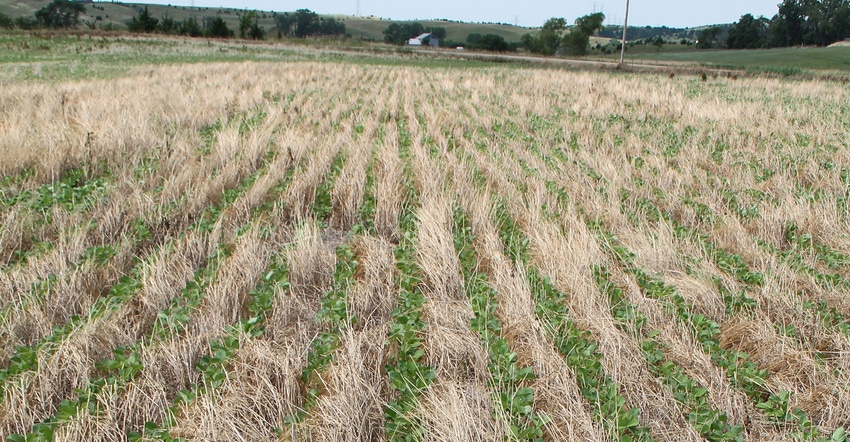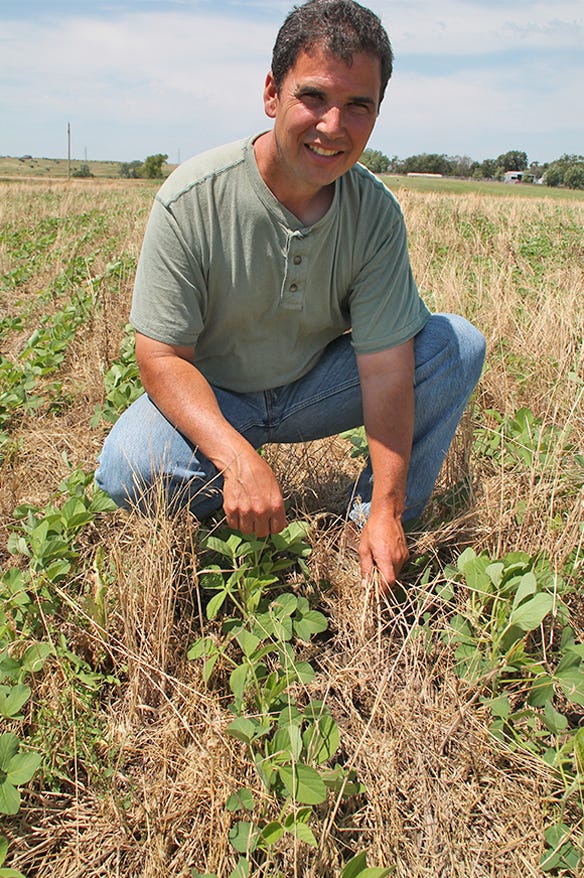April 25, 2017

By Loretta Sorensen
A couple of years ago, Chris Nelsen didn’t disk or plow land coming out of the Conservation Reserve Program. He burned the residue instead. He hoped to reduce the residue that would interfere with planting, but preserve the soil structure that had developed while the land was idled.
“The tilth of that field was so mellow, it was like digging down into cottage cheese anywhere I took a soil sample. That kind of soil structure allows for a high degree of water infiltration. It seemed counterproductive to destroy it,” Nelsen says.
Initially, Nelsen planned to plant corn in the field. Wet spring conditions forced him to plant soybeans. He used treated seeds and put down about 156,000 seeds per acre.

CRP CONVERSION: Chris Nelsen had good luck no-tilling soybeans into land coming out of the Conservation Reserve Program. (Photo: Loretta Sorensen)

“I was able to utilize the fertilizer strips I had set up the previous fall when I expected to plant corn in that field,” Nelsen says. “A week before planting, I did a Roundup burndown to take care of any ragged spring growth. Using full planter downforce and some additional attachments, planting went smoothly.”
The same day Nelsen planted, the field received between 1 and 1.25 inches of rain.
“In terms of moisture, 2016 was a storybook year for soybeans,” Nelsen says. “Wet conditions kept us from planting the field until the last part of June, so we were happy with the yield. We started the season with a full plate, having adequate soil profile moisture, high-quality soil structure, cool temperatures and timely rains when pods were filling.”
By harvest, the soybeans were waist-high, and the field averaged 56 bushels per acre. Throughout the Northern Plains, 2016 soybean yields ran high, so Nelsen can’t know exactly how his soybean crop benefited from the field’s soil quality.
Nelsen saw further evidence of the field’s high level of soil organic matter after harvest. All of the grass residue he had planted into was completely decomposed by fall.
“Once you get a healthy population of soil microorganisms in a field, it quickly causes residue breakdown,” Nelsen says.
Some grass regrowth and weed pressure may have negatively impacted the soybeans. Still, he harvested an above-average yield.
“My plan [to burn down CRP rather than till it] raised the eyebrows of some agronomists I know, and I certainly wondered how things would turn out,” Nelsen says. “Burning down the residue rather than plowing it was a good decision, and I would do it again in a similar situation.”
Sorensen is freelance writer and book author. She writes from a hobby farm near Yankton, S.D., where she and her husband raise and work Belgian draft horses.
You May Also Like




